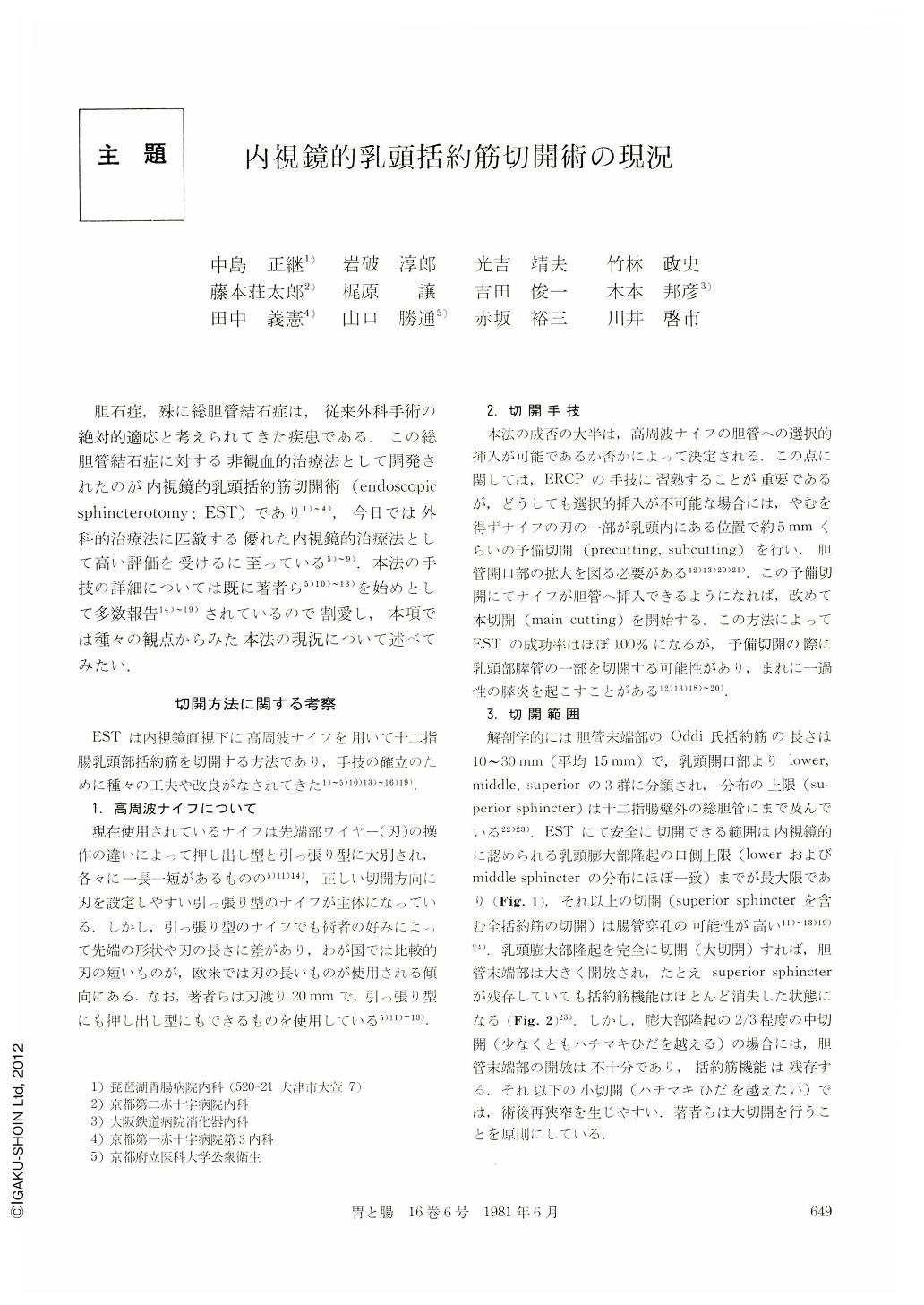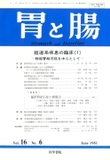Japanese
English
- 有料閲覧
- Abstract 文献概要
- 1ページ目 Look Inside
胆石症,殊に総胆管結石症は,従来外科手術の絶対的適応と考えられてきた疾患である.この総胆管結石症に対する非観血的治療法として開発されたのが内視鏡的乳頭括約筋切開術(endoscopic sphincterotomy;EST)であり1)~4),今日では外科的治療法に匹敵する優れた内視鏡的治療法として高い評価を受けるに至っている5)~9).本法の手技の詳細については既に著者ら5)10)~13)を始めとして多数報告14)~19)されているので割愛し,本項では種々の観点からみた本法の現況について述べてみたい.
Within only several years of the development, endoscopic sphincterotomy (EST) of the papilla of Vater has become an acceptable alternative to transabdominal surgery for treatment of biliary tract diseases, especially that of stones. Recently, the techniques, instruments and indications for EST have rapidly evolved.
The success rate of EST depends on the selective cannulation of a sphincterotomy into the distal common bile duct and it is now more than 98% of the cases by using improved instruments and by introducing a precutting technique. The safe electrosurgical section of the sphincter should be limited to the proximal end of the roof of the papilla visualized through an endoscope. After the adequate EST, the superior sphincter of the distal common bile duct remains, but it is functionally effaced. This means that EST appears functionally and morphologically similar to transduodenal surgical sphincteroplasty though it is an electrosurgical sphincterotomy. New techniques for removal of biliary tract stones have also been developed in addition to the ordinary techniques. One is a direct endoscopic extraction with peroral cholangioscopy under sliding tube guidance, which can open a possibility for removal of intrahepatic stones after EST.The other is the electrohydraulic lithotriply which makes it possible to retrieve huge stones within the common bile duct. These techniques can eliminate the limitations for gallstone removal and can enlarge the indications for EST.
In our series since 1973, EST was accomplished in 313 0f 322 patients (97.2%) and was effective in 305 patients (94.7%). Of 289 patients with biliary tract stones in whom EST was performed, stones were completely removed in 281 patients (97.2%); 83 patients by spontaneous passage, 157 patients by basket retrieval and 41 patients by the combined use of both processes including peroral cholangioscopic approaches and electrohydraulic lithotripsies. The size of stones removed following EST ranged from 5 to 45 mm, mostly between 10 to 20 mm in diameter. In poor operative risk choledocholithiasis patients with or without an intact gallbladder, no cholecystectomy was attempted following EST and removal of common bile duct stones. On the other hand, in patients with cholecystocholedocholithiasis scheduled for laparotomy, only simple cholecystectomy was accomplished after complete removal of biliary tract stones by EST. In patients with intrahepatic cholelithiasis, basket retrieval of stones was successful under direct vision by the use of a specially designed peroral cholangioscope. In 19 patients with benign stenosis of the papilla, EST also proved to be effective for obviating their cholestases. In five patients with biliary tract tumor, peroral cholangioscopic inspection of the duct and biopsy from the lesion were successful following EST. In our series, eight acute complications and three late ones occurred in 313 sphincterotomies (morbidity rate: 3.5%), and one death with septic cholangitis due to stone impaction was recognized (mortality rate: 0.3%). The results apparently show that EST is a safe and effective procedure with a relatively low complication rate as compared with that of surgical approaches.
The indications for EST are now classified into therapeutic and diagnostic aids owing to the improvement of the techniques and instruments. The first and main indication for therapeutic EST is various types of biliary tract stones, especially residual or recurrent choledocholithiasis after cholecystectomy. The second therapeutic indication is stenosis of the papilla which does not extend above the intramural portion of the distal common bile duct. The diagnostic indication for EST is any ductal abnormality of the biliary tract suggesting tumor or inflammation which require further precise diagnosis such as direct endoscopy and biopsy of the lesions. The newly developed technique of peroral cholangioscopy under sliding tube guidance can provide good visualization of the ductal lumen and makes it possible to take biopsy from the lesions under direct vision. The increasing use of this technique may lead to early detection of tumors of the duct that may be overlooked or hardly differentiated by conventional methods.
EST is now shown to be a practical and effective procedure with a low complication rate. The technique has also led to peroral cholangioscopy and transendoscopic instrumentation of the biliary tract. The widespread availability of EST should open a new chapter in the management of biliary tract disease.

Copyright © 1981, Igaku-Shoin Ltd. All rights reserved.


